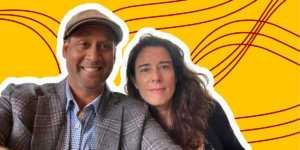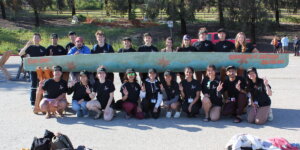
The winning teams celebrate with CEE department chair Burçin Becerik-Gerber and members of the judging panel
From shade-scarcity to battles for the last parking spot… Los Angeles is a city of problems. For civil and environmental engineers, that means it’s a place of opportunity – every problem is an invitation for innovation.
However, identifying the big idea and designing effective implementation is just the start. As students at the Sonny Astani Department of Civil & Environmental Engineering (CEE) know well, engineers also need to be expert communicators. The proof is in the pitch.
That’s the motivation behind the Das Family Innovate x LA Student Competition, established with the generous support of the Das family. The competition gathers steam over several months, as entrepreneurial student engineers brainstorm ideas and receive mentorship. The competition is led by a team of faculty members including Burcin Becerik-Gerber, David Gerber, Brad Cracchiola and Daniel Druhora, as well as student advisor Maral Laurie Mardirossians. Julieta Moradei, a structural engineer and venture capitalist investing in early-stage housing and construction start-ups, has played an important role as a consultant, providing guidance to student teams throughout the competition.
April 14 saw the teams come together for the final pitch day, gathering at the Ronald Tutor Campus Center to present to a panel of industry professionals, including start-up founders, venture capitalists and alumni members of the Das family.
The goal is to equip students with the skills to develop compelling pitches and launch their own start-up. It’s also about workshopping smart ideas into practical and effective solutions which reflect the core themes of CEE’s strategic vision: engineering for disaster resilience, extreme habitats, environmental stewardship, transport service systems and urban livability. In short, engineering the future.
“This is one of the very few innovation competitions held in the context of civil and environmental engineering education,” said Becerik-Gerber. “This is important, because many of society’s most challenging issues are in this area – from climate change, to disaster resilience, to water scarcity, to improving quality of life as our cities expand into megacities. Civil and environmental engineers are among our most impactful and innovative change-makers.”
And the winner is…
Below, you’ll find a summary of each team’s big idea – which one would you choose? The panel selected Sustana, a project focusing on sustainable farming, developed by Vidhur Senthil (an undergraduate majoring in computer science) and Mirmahdi Seyedrezaei (a PhD student at CEE). The judges praised the idea for its potential scope of impact, scalability, strong revenue model and low barrier to entry.

Members of the judging panel (Ching Wei, Kelly Das, Santanu Das)
Second prize was awarded to Green Beings, an interdisciplinary team including Connie Devenport (majoring in environmental engineering), Ashley Espinosa (majoring in urban studies and planning), Brianna Brothers (majoring in psychology and minoring in addiction studies) and Judith Gauriau (a doctoral student studying geological sciences). Both the winning projects share an emphasis on the ecological infrastructure that supports human flourishing in urban areas; as a city originally founded on acres of fertile farmland, perhaps LA’s roots provide a clue to its future?
Sustana
Vidhur Senthil, Mirmahdi Seyedrezaei
“Farming in California gets more challenging every year, as our natural resources become increasingly scarce. We can see the effects of increasing food prices as it becomes harder for farms to meet demands due to our historical drought. On top of that, the large reliance on industrial fertilizers causes contaminated drinking water, especially in lower-income communities. We are at a crucial point where we have the opportunity to fix a lot of these issues before they become untenable.
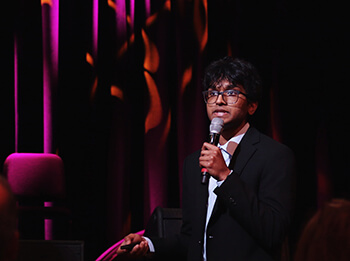
Vidhur Senthil presents the pitch for Sustana
Sustana is designed to help farmers incorporate sustainable agriculture techniques to reduce water and fertilizer use, saving money in the long run.
Our idea seeks to tap into the potential of cover crops. Not only will we be able to reduce water and fertilizer inputs, but we would also improve the quality of the land for the next generation of farmers. However, to reach an ideal scenario where all farms can participate in sustainable agriculture, there needs to be a significant change in government regulation and the way our farming industry operates. As the problems with old techniques start to become more serious, there will be a breaking point where a lot of big decisions will need to be made.”
The process of developing a pitch has shown us how crucial it is to understand the problem and engage in customer discovery research before proposing a feasible solution. Overall, I’m grateful for the amazing mentorship we have received from all the people running the competition.”
Green Beings / UmbreLA
Connie Devenport, Ashley Espinosa, Brianna Brothers, Judith Gauriau
“The urban heat island effect is a problem that concerns all Angelenos, and parking lots are among the primary culprits: surfaces that generate extreme heat on sunny days.
![[TBC] presents the pitch for UmbreLA](https://viterbischool.usc.edu/wp-content/uploads/2023/04/green-beings_resized.jpg)
Ashley Espinosa presents the pitch for UmbreLA (Green Beings)
Our idea requires input from the City of Los Angeles, with a pilot program to advertise the product, which could be expanded to serve spaces such as schoolyards and eventually even the private sector.
Our first brainstorming session was very insightful – our team had many ideas and the same philosophy about what we would love LA to look like. Once we decided that we wanted to tackle the heat island effect, the challenge was to find an original and creative idea that truly met a human need. Our main takeaway from this experience is that an idea does not come to fruition without the input of many different competing opinions.”
TranSync
James Huang, Lilly Clark, Alex Wang
“Being among the millions of public transit users in Los Angeles, our team knows how stressful and time-consuming it can be to traverse the ‘last mile’ – the distance between a transit stop and your final destination.
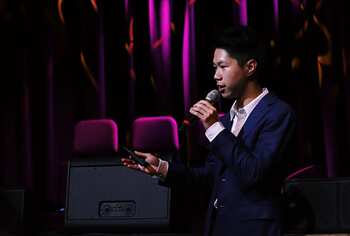
Alex Wang presents the pitch for TransSync
Arguably, this problem is most visible in our fixed guideway transit services – think light rail, heavy rail, and busways. In those cases, you can cover a good distance quickly, but the challenge comes when it’s time to travel from the station nearest your eventual destination. That last mile can easily represent half or even more of the total travel time.
TranSync aims to solve this. By integrating public transit agencies, rideshare, and shared mobility companies to deliver a better last mile – one that’s quicker, easier, more efficient, and comparably stress-free.
Reclaiming travelers’ valuable time is a part of our central focus. Also, we’d hope that solving the last mile problem would make public transit more appealing, ultimately pulling more people out of their cars – thereby reducing emissions and wear on road infrastructure.”
Arrival
Xinyao Zhang, Zhexian Li
“The frustration of a blind search for a parking space is shared among the 6.5 million drivers in LA. Statistics show that LA drivers spend significant time and billions of dollars on parking searches – not to mention the negative effect on the city environment due to extra carbon emissions.
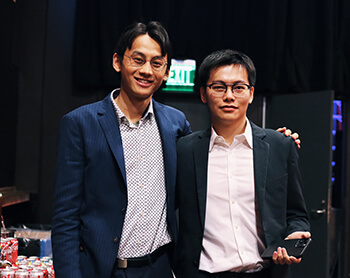
Xinyao Zhang and Zhexian Li
We are building a smart parking platform, Arrival, to help drivers access information such as parking availability and reserving their optimized parking options. We see it as the “Doordash” +” Yelp” for parking.
With Arrival, drivers are able to check parking availability via an app and reserve an optimized parking option before or upon arrival at their destination. The city’s traffic condition in popular locations will also be improved on account of the streamlined process. Parking business owners should see a revenue boost since their parking spaces will be more efficiently utilized with a better turnover rate. Our optimization algorithm will also systematically calculate and recommend the best parking options for each area to improve overall efficiency.”
Published on April 19th, 2023
Last updated on April 19th, 2023




